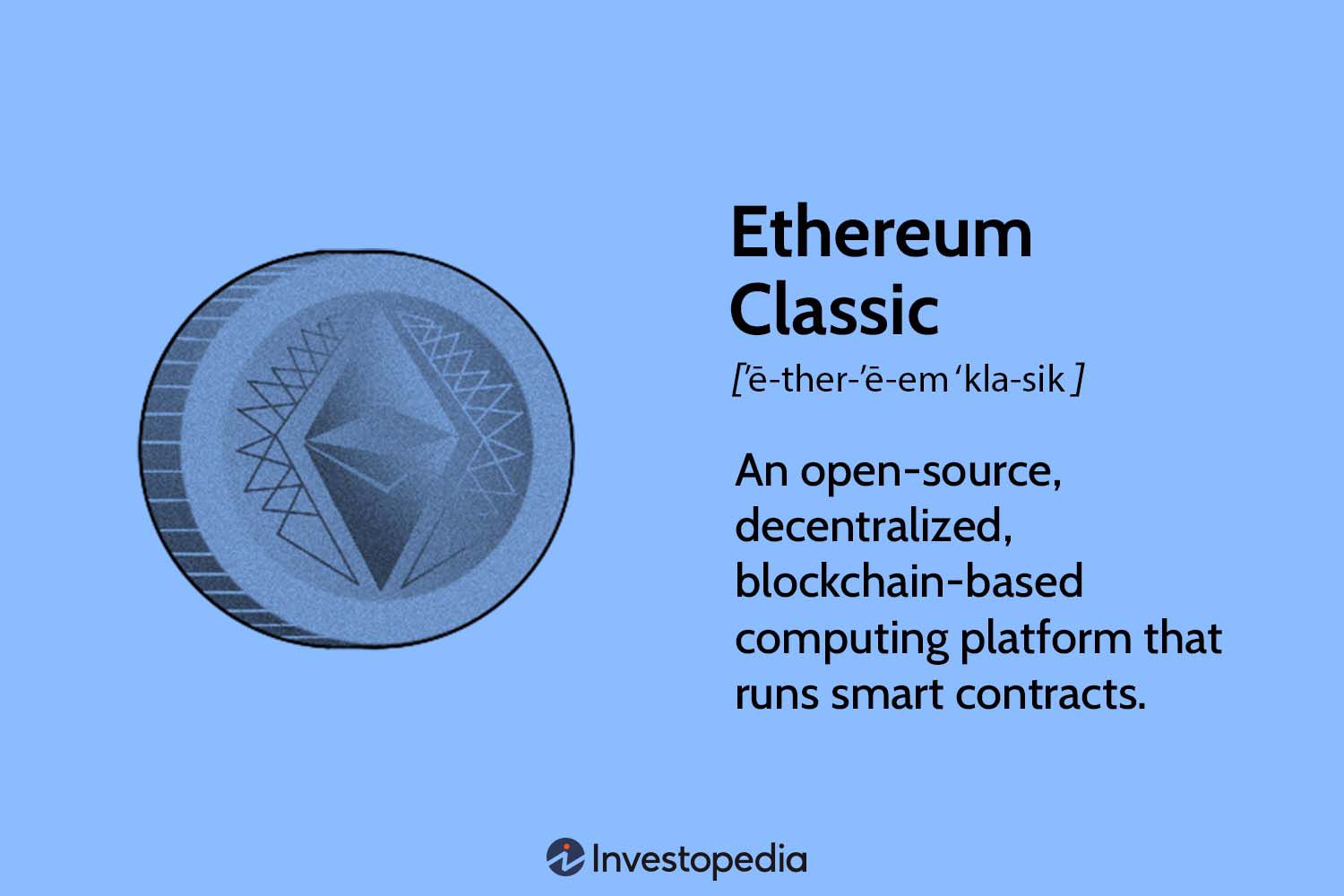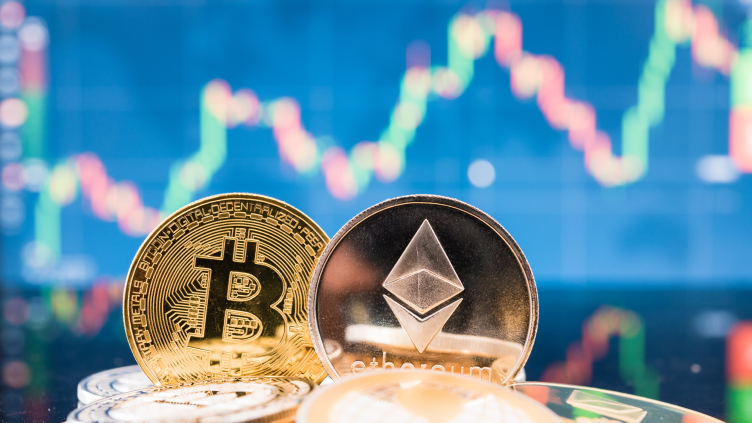Ethereum
Ethereum Classic (ETC) Definition, History and Future

What is Ethereum Classic (ETC)?
Ethereum Classic (ETC) is a Open source, a decentralized, blockchain-based distributed cryptocurrency platform that executes smart contracts. Ethereum Classic was created in 2016 after the decentralized autonomous organization (DAO)which used smart contracts operating on the Ethereum blockchain, was hacked. The original blockchain was split in two, with the majority of users opting to undo the hack and return the stolen funds. Ethereum Classic and Ethereum are rooted in the same code but have different technical and philosophical differences.
Key takeaways
- Ethereum Classic is an open source, decentralized, blockchain-based distributed cryptocurrency platform that executes smart contracts.
- Ethereum Classic is the original Ethereum blockchain.
- It was designed by Vitalik Buterin and the Ethereum Foundation and launched in 2015.
- Ethereum Classic was created after the DAO hack in 2016.
- A dispute caused a split within the Ethereum community, with the majority choosing to roll back the hack while Ethereum Classic did not accept the rollback.
Understanding Ethereum Classic (ETC)
Ethereum Classic is a blockchain platform. It facilitates smart contracts, which automate actions via blockchain. For example, if one party agreed to sell an item at a specific price to another, the smart contract would automate payment and transfer of ownership, eliminating the need to trust that either party would fulfill its obligations.
As noted above, the blockchain was split into ETC and Ethereum after a hacking incident. This split revealed philosophical divisions within the Ethereum community. Operating under the premise that code is law, a small number of developers and miners believed that DAO investors should suffer the consequences of investing in a broken system. cryptocurrency project. However, the majority of the Ethereum community has decided to roll back the blockchain, creating a safety plan for investors.
Many upgrades and improvements have been made to the ETC project since the split. The project’s goal continues to work toward becoming a global payments network using smart contracts that can operate without centralized governance. As with other cryptocurrencies, Ethereum Classic will likely continue to strive to be a digital store of valuemeaning it can be saved and traded while retaining its value.
As of May 27, 2024, ETC’s peak supply was 210.70 million coins, with 147.26 million coins in circulation. Cryptos market capitalization was $4.69 billion.
Similar to Bitcoin, Ethereum Classic records transactions of value. It can also be used as a distributed computer to run self-executing programs. smart contracts.
History of Ethereum Classic
Ethereum was designed by Vitalik Buterin and the Ethereum Foundation and launched in 2015. The Ethereum blockchain was created as a network where transactions were facilitated using its native token. ether (ETH). The new network quickly became popular with initial coin offerings (ICO)as different teams used the platform to launch their own tokens.
One of the most successful ICOs was the DAO, a decentralized venture capital fund in which investors voted on which assets to invest in. This fund quickly accumulated over 11 million ETH from over 18,000 investors before unknown hackers discovered a smart contract bug allowing them to withdraw approximately a third of the DAO’s accumulated ether.
Due to the scale of the hack, many investors have proposed reversing the Ethereum blockchain to rescue affected investors, while others have argued that it would set a precedent for future bailouts. Up to 85% of network miners have moved to hard fork.
As a result, the Ethereum blockchain split into two separate networks. The newer network inherited the name Ethereum and the native token Ether. The old one was renamed Ethereum Classic. It also uses ether, but it has a different symbol, ETC. The network saw a migration of miners after Ethereum integrated proof-of-stake in 2022. Developers created several applications using its virtual machine.
Concerns about Ethereum Classic
Although Ethereum and Ethereum Classic offer smart contracts and seek the same thing walk, Ethereum remains the more popular of the two networks. Ethereum’s ETH is second only to Bitcoin as the world’s most valuable cryptocurrency network.
One of the main concerns with Ethereum Classic is its potential scalability limitations. The network can handle between 10 and 20 transactions per second, but this number is much lower than traditional payment networks. Although Ethereum Classic has undergone numerous software upgrades, the scalability of its payment systems remains one of its biggest challenges.
Regulation of the cryptocurrency market continue to grow, which may or may not change how Ethereum Classic (and other networks) work.
The Future of Ethereum Classic
The future of ETC looks less promising than that of Ethereum since Ethereum remains the more popular of the two networks.
Blockchain and cryptocurrency have failed to gain much traction in the market, losing market share to other cryptocurrencies, notably Bitcoin. ETC continues to trade on exchanges and is operated by the crypto community. Blockchain and cryptocurrency are clinging to a seemingly solid base of traders and fans.
Like Ethereum, ETC has an improvement proposal process. Since its hard fork, it has undergone several upgrades, such as developing compatibility with the latest Ethereum modifications. Despite all this, demand for ETC remains strong and it is possible that blockchain and cryptocurrency will remain competitors in this space.
Ethereum Classic vs. Ethereum
One of the most significant differences from Ethereum is that Ethereum Classic retained its proof-of-work mechanism and competitive reward system that Ethereum used before the merger. This means that Ethereum Classic’s token can be mined, while Ethereum’s cannot.
Another difference is that Ethereum has no limit on the number of tokens which can be delivered. Ethereum Classic has a limit of 210.7 million coins that will be introduced one day. Every five million blocks, the Ethereum Classic blockchain undergoes a fifth. This event is similar to the Bitcoin halving, where block rewards are reduced by 20% every two years. The final fifth occurred in 2022, bringing the reward to 2.56 ETC. The next fifth is expected in June 2024 and the reward will be reduced to 2,048 ETC.
This reduction in rewards every two years is expected to continue. Up to 95% of ETC will be exploited by 2059.
Does Ethereum Classic have a future?
Ethereum Classic has had its ups and downs since splitting from Ethereum. It continues to grow and has a consistent base of traders, investors, and users. Its future depends on its ability to maintain its position as an attractive cryptocurrency and blockchain.
Can Ethereum Classic reach $10,000?
As with any other type of security, it is difficult to predict what will happen to cryptocurrency prices. ETC could reach $10,000, but it is just as likely that it will collapse and become worthless.
Is Ethereum Classic a good buy?
It depends on your outlook, preferences and risk tolerance. It also depends entirely on how the market is doing and when you decide to create an entry point. Your trading strategy also determines the viability of an investment in Ethereum Classic. For example, you can choose to buy and hold cryptocurrency as a long-term investment or keep it in your wallet for a short period of time.
The essential
Ethereum Classic is a blockchain that spun off from Ethereum in 2016. It maintains the blockchain that existed before the community voted to unstate the Ethereum blockchain after thieves stole millions from investors.
The comments, opinions and analyzes expressed on Investopedia are for online information purposes. Read our warranty and exclusion of liability for more information.
Ethereum
QCP sees Ethereum as a safe bet amid Bitcoin stagnation

QCP, a leading trading firm, has shared key observations on the cryptocurrency market. Bitcoin’s struggle to surpass the $70,000 mark has led QCP to predict Selling pressure is still strong, with BTC likely to remain in a tight trading range. In the meantime, Ethereum (ETH) is seen as a more promising investment, with potential gains as ETH could catch up to BTC, thanks to decreasing ETHE outflows.
Read on to find out how you can benefit from it.
Bitcoin’s Struggle: The $70,000 Barrier
For the sixth time in a row, BTC has failed to break above the $70,000 mark. Bitcoin is at $66,048 after a sharp decline. Many investors sold Bitcoin to capitalize on the rising values, which caused a dramatic drop. The market is becoming increasingly skeptical about Bitcoin’s rise, with some investors lowering their expectations.
Despite the continued sell-off from Mt. Gox and the US government, the ETF market remains bullish. There is a notable trend in favor of Ethereum (ETH) ETFs as major bulls have started investing in ETFs, indicating a bullish sentiment for ETH.
QCP Telegram Update UnderlinesIncreased market volatility. The NASDAQ has fallen 10% from its peak, led by a pullback in major technology stocks. Currency carry trades are being unwound and the VIX, a measure of market volatility, has jumped to 19.50.
The main factors driving this uncertainty are Value at Risk (VaR) shocks, high stock market valuations and global risk aversion sentiment. Commodities such as oil and copper have also declined on fears of an economic slowdown.
Additionally, QCP anticipates increased market volatility ahead of the upcoming FOMC meeting, highlighting the importance of the Federal Reserve’s statement and Jerome Powell’s subsequent press conference.
A glimmer of hope
QCP notes a positive development in the crypto space with an inflow of $33.7 million into ETH spot ETFs, which is giving a much-needed boost to ETH prices. However, they anticipate continued outflows of ETHE in the coming weeks. The recent Silk Road BTC moves by the US government have added to the market uncertainty.
QCP suggests a strategic trade involving BTC, which will likely remain in its current range, while ETH offers a more promising opportunity. They propose a trade targeting a $4,000-$4,500 range for ETH, which could generate a 5.5x return by August 30, 2024.
Ethereum
Ethereum Whale Resurfaces After 9 Years, Moves 1,111 ETH Worth $3.7 Million

An Ethereum ICO participant has emerged from nearly a decade of inactivity.
Lookonchain, a smart on-chain money tracking tool, revealed On X, this long-inactive participant recently transferred 1,111 ETH, worth approximately $3.7 million, to a new wallet. This significant move marks a notable on-chain movement, given the participant’s prolonged dormancy.
The Ethereum account in question, identified as 0xE727E67E…B02B5bFC6, received 2,000 ETH on the Genesis block over 9 years ago.

This initial allocation took place during the Ethereum ICOwhere the participant invested in ETH at around $0.31 per coin. The initial investment, worth around $620 at the time, has now grown to millions of dollars.
Recent Transactions and Movements
The inactive account became active again with several notable output transactions. Specifically, the account transferred 1,000 ETH, 100 ETH, 10 ETH, 1 ETH, and 1 more ETH to address 0x7C21775C…2E9dCaE28 within a few minutes. Additionally, it moved 1 ETH to 0x2aa31476…f5aaCE9B.
Additionally, in the latest round of transactions, the address transferred 737,995 ETH, 50 ETH, and 100 ETH, for a total of 887,995 ETH. These recent activities highlight a significant movement of funds, sparking interest and speculation in the crypto community.
Why are whales reactivating?
It is also evident that apart from 0xE727E67E…B02B5bFC6, other previously dormant Ethereum whales are waking up with significant transfers.
In May, another dormant Ethereum whale made headlines when it staked 4,032 ETHvalued at $7.4 million, after more than two years of inactivity. This whale initially acquired 60,000 ETH during the Genesis block of Ethereum’s mainnet in 2015.
At the time, this activity could have been related to Ethereum’s upgrade known as “Shanghai,” which improved the network’s scalability and performance. This whale likely intended to capitalize on the price surge that occurred after the upgrade.
Disclaimer: This content is informational and should not be considered financial advice. The opinions expressed in this article may include the personal opinions of the author and do not reflect the opinion of The Crypto Basic. Readers are encouraged to conduct thorough research before making any investment decisions. The Crypto Basic is not responsible for any financial losses.
-Advertisement-
Ethereum
Only Bitcoin and Ethereum are viable for ETFs in the near future

BlackRock: Only Bitcoin and Ethereum Are Viable for ETFs in the Near Future
Bitcoin and Ethereum will be the only cryptocurrencies traded via ETFs in the near future, according to Samara Cohen, chief investment officer of ETFs and indices at BlackRock, the world’s largest asset manager.
In an interview with Bloomberg TV, Cohen explained that while Bitcoin and Ethereum have met BlackRock’s rigorous criteria for exchange-traded funds (ETFs), no other digital asset currently comes close. “We’re really looking at the investability to see what meets the criteria, what meets the criteria that we want to achieve in an ETF,” Cohen said. “Both in terms of the investability and from what we’re hearing from our clients, Bitcoin and Ethereum definitely meet those criteria, but it’s going to be a while before we see anything else.”
Cohen noted that beyond the technical challenges of launching new ETFs, the demand for other crypto ETFs, particularly Solana, is not there yet. While Solana is being touted as the next potential ETF candidate, Cohen noted that the market appetite remains lacking.
BlackRock’s interest in Bitcoin and Ethereum ETFs comes after the successful launch of Ethereum ETFs last week, which saw weekly trading volume for the crypto fund soar to $14.8 billion, the highest level since May. The success has fueled speculation about the next possible ETF, with Solana frequently mentioned as a contender.
Solana, known as a faster and cheaper alternative to Ethereum, has been the subject of two separate ETF filings in the US by VanEck and 21Shares. However, the lack of CME Solana futures, unlike Bitcoin and Ethereum, is a significant hurdle for SEC approval of a Solana ETF.
Despite these challenges, some fund managers remain optimistic about Solana’s potential. Franklin Templeton recently described Solana as an “exciting and major development that we believe will drive the crypto space forward.” Solana currently accounts for about 3% of the overall cryptocurrency market value, with a market cap of $82 billion, according to data from CoinGecko.
Meanwhile, Bitcoin investors continue to show strong support, as evidenced by substantial inflows into BlackRock’s iShares Bitcoin Trust (NASDAQ: IBIT). On July 22, IBIT reported inflows of $526.7 million, the highest single-day total since March. This impressive haul stands in stark contrast to the collective inflow of just $6.9 million seen across the remaining 10 Bitcoin ETFs, according to data from Farside Investors. The surge in IBIT inflows coincides with Bitcoin’s significant $68,000 level, just 8% off its all-time high of $73,000.
Ethereum
Ethereum Posts First Consecutive Monthly Losses Since August 2023 on New ETFs

Available exclusively via
Bitcoin ETF vs Ethereum: A Detailed Comparison of IBIT and ETHA
Andjela Radmilac · 3 days ago
CryptoSlate’s latest market report takes an in-depth look at the technical and practical differences between IBIT and BlackRock’s ETHA to explain how these products work.
-

 Ethereum12 months ago
Ethereum12 months agoEthereum Posts First Consecutive Monthly Losses Since August 2023 on New ETFs
-

 Regulation12 months ago
Regulation12 months agoCryptocurrency Regulation in Slovenia 2024
-

 News12 months ago
News12 months agoNew bill pushes Department of Veterans Affairs to examine how blockchain can improve its work
-

 Regulation12 months ago
Regulation12 months agoThink You Own Your Crypto? New UK Law Would Ensure It – DL News
-

 Regulation12 months ago
Regulation12 months agoUpbit, Coinone, Bithumb Face New Fees Under South Korea’s Cryptocurrency Law
-

 Regulation12 months ago
Regulation12 months agoA Blank Slate for Cryptocurrencies: Kamala Harris’ Regulatory Opportunity
-

 Regulation12 months ago
Regulation12 months agoBahamas Passes Cryptocurrency Bill Designed to Prevent FTX, Terra Disasters
-

 Regulation12 months ago
Regulation12 months agoIndia to Follow G20 Policy for Cryptocurrency Regulation: MoS Finance
-

 News1 year ago
News1 year ago“Captain Tsubasa – RIVALS” launches on Oasys Blockchain
-

 Ethereum1 year ago
Ethereum1 year agoComment deux frères auraient dérobé 25 millions de dollars lors d’un braquage d’Ethereum de 12 secondes • The Register
-

 News12 months ago
News12 months agoEU supports 15 startups to fight online disinformation with blockchain
-

 News1 year ago
News1 year agoSolana ranks the fastest blockchain in the world, surpassing Ethereum, Polygon ⋆ ZyCrypto





